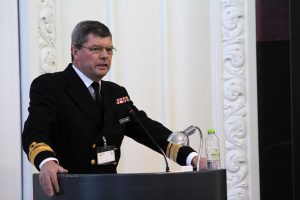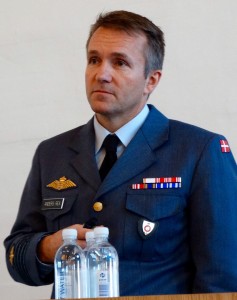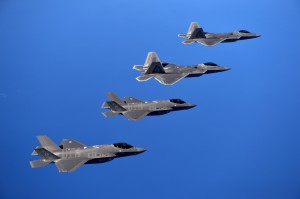2017-11-17 By Robbin Laird and Ed Timperlake
Denmark is a small country, but an important player in the NATO Alliance and part of the reworking of Nordic defense with Norway, Sweden and Finland to deal with resurgent Russia.
Notably, in mid-October 2017, the Danish government released its proposed new six-year defense guidance and defense spending guidelines.
The government was very clear about what the threats facing Denmark are, the importance of allies modernizing and working effective interdependence in the defense of the North Atlantic and beyond, and need to invest more in new equipment and personnel.
Here is how the Danish government in the document describes the way ahead for Denmark:
“Denmark faces more serious threats than in any other period following the fall of the Berlin Wall. The freedom and security we value so highly cannot be taken for granted.
“To the east, NATO faces a confrontational and assertive Russia. Instability in the Middle East and North Africa is fuelling militant Islamism, sowing the seeds for the threat of terror and irregular migration flows. Propaganda campaigns challenge our democratic principles and established rules, while in the Arctic, there is increased activity and military presence.
“These are challenges which we cannot afford to ignore. That is why the Government wishes to substantially increase military spending over the next six years.
“The substantial increase will be gradually phased in and ultimately result in the Danish Defence’s annual budget in 2023 being increased by DKK 4.8 billion.
This amounts to an increase of 20% compared to current military spending.
Threats in cyberspace have serious security and socio-economic consequences.”
During a recent visit to Copenhagen, which coincided with the release of the new defence guidance, there was a chance to talk with a number of Danes and various experts about Danish thinking and the approach they had in mind to deal with shaping a deterrent strategy.
In particular, the discussion with Rear Admiral Nils Wang, former head of the Danish Navy and now head of the Danish Royal Military Academy, was significant in characterizing the nature of the Russian challenge as well as a way ahead for the Danish forces.
Rear Admiral Wang clearly argued that the Russian challenge today and as it is evolving has little to do with the Cold War Soviet-Warsaw Pact threat to the Nordics.
 Rear Admiral Nils Wang.
Rear Admiral Nils Wang.
The Soviet-Warsaw threat was one of invasion and occupation and then using Nordic territory to fight U.S. and allied forces in the North Atlantic.
In many ways, this would have been a repeat of how the Nazis seized Norway during a combined arms amphibious operation combined with a land force walk into Denmark.
In such a scenario, the Danes along with their allies were focused on sea denial through use of mines, with fast patrol boats providing protection for the minelayers.
Aircraft and submarines were part of a defense in depth strategy to deny the ability of the Soviets to occupy the region in time of a general war.
He contrasted this with the current and evolving situation in which the Russians were less focused on a general war, and more on building out capabilities for a more limited objective, namely controlling the Baltic States.
He highlighted the nature of the arms modernization of the Russian military focused on ground based missile defense and land and sea based attack missiles along with airpower as the main means to shape a denial in depth strategy which would allow the Russians significant freedom of maneuver to achieve their objectives within their zone of strategic maneuver.
A core asset carried by the Russian forces is the Kalibr cruise missile, which can operate off of a variety of platforms. With a dense missile wolf pack so to speak the Russians provide a cover for their maneuver forces. They are focused on using land based mobile missiles in the region as their key strike and defense asset
“The Russian defense plan in the Baltic is all about telling NATO we can go into the Baltic countries if we decided to do so. And you will not be able to get in and get us out. That is basically the whole idea.”
Rear Admiral Wang argued for a reverse engineering approach to the Russian threat.
He saw the “reverse engineering” approach as combing several key elements: a combined ASW, F-35 fleet, frigate and land based strike capabilities, including from Poland as well.
 Vladimir Putin with the Russian Chief of the General Staff, during the Zapad 17 exercise. Credit: TASS
Vladimir Putin with the Russian Chief of the General Staff, during the Zapad 17 exercise. Credit: TASS
The Admiral’s position is based in part on the arrival of the F-35 and notably the F-35 as a core coalition aircraft with a capability to work closely with either land based or sea based strike capabilities.
“One needs to create air superiority, or air dominance as a prerequisite for any operation at all, and to do that NATO would need to assemble all the air power they can actually collect together, inclusive carrier-based aircraft in the Norwegian Sea.
“This is where the ice free part of the Arctic and the Baltic gets connected. We will have missions as well in the Arctic at the northern part of Norway because the Norwegians would be in a similar situation if there is a Baltic invasion.”
Rear Admiral Wang argued as well for a renewal or augmentation of ASW capabilities by the allies to deal with any Russian submarines in the Baltic supporting the operation, notably any missile carrying submarines.
He saw a focused Danish approach to frigate/helo based ASW in the region as more important than buying submarines to do the ASW mission.
The importance of using the F-35 as a trigger force for a sea-based missile strike force suggests that one option for the Danes will be to put new missiles into their MK-41 tubes which they have on their frigates.
They could put SM-2s or SM-3s or even Tomahawks onto their frigates dependent on how they wanted to define and deal with the Russian threat.
The ongoing work on Aegis integration with F-35 or the USMC work on integrating their High Mobility Artillery Rocket System (HIMARS) launchers is suggestive of their approach.
And leveraging the F-35 as the flying combat system part of the overall strike and defense force is a key part of Danish thinking.
During the recent stay in Copenhagen, there was a chance to discuss this as well with the new head of the Royal Danish Air Force, Col. Anders Rex.
“When I talk with F-35 pilots, the same message is drilled into me – this is not a replacement aircraft; this is not like any aircraft you have flown before. The aircraft enables our air combat forces to play a whole new ballgame.
“And from my discussions with Australians, the Norwegians, the Dutch and the Brits, it is clear that the common drive is to shape a fifth generation combat force, not simply fly the current 256 F-35s as cool, new jets.”
 Col. Anders Rex, Danish Air Force. seen at the Copenhagen Airpower Conference, 2015. Credit: Second Line of Defense
Col. Anders Rex, Danish Air Force. seen at the Copenhagen Airpower Conference, 2015. Credit: Second Line of Defense
He clearly had in mind working on leveraging the introduction of the F-35 to trigger a broader transformation.
And this makes sense, because in large part the F-35 is not simply a fighter which you define but what it does by itself organically, but, rather by what it can trigger in the overall combat fleet, whether lethal or non-lethal payloads.
“We need to focus on the management of big data generated by the F-35 and other assets that will come into the force.
“How do we do the right kind of command and control within a rich information battlespace?
“We need to build self-learning systems as well.
“The F-35 is a revolutionary man-machine system and sets in motion not only the challenge of new approaches to working information and C2, but new approaches to combat learning.
“How do we get there?
“That is what generating a fifth generation combat force is all about.”
An American colleague who has worked in Denmark for several years at the Centre for Military Studies at the University of Copenhagen highlighted the growing cooperation among the Nordics and how that cooperation was reshaping their operational approaches to dealing with the Russian threat.
Notably, the Swedes are introducing conscription, the Norwegians are enhancing their defense spending and the Finns are working new relationships in the region.
As Dr. Gary Schaub, Jr. put it during a meeting in Copenhagen:
“The Nordics are looking for practical ways ahead on credible deterrence with regard to the Russians.
“In this collaborative environment between equal—but small—powers, the suggestions of a Britain or US could smooth over the small barriers that might keep these otherwise pragmatic nations from doing what is in their own, and their region’s, common interests.
“There is a huge opportunity for the new Administration to shape a thoughtful proactive NORDIC agenda as the Nordics themselves seek a more regional approach.
“And as F-35s and P-8s come into the region, there is an opportunity to leverage common assets to shape a more proactive and common effort towards regional defense and security.
“The Administration should seize it.”
An earlier version of this article was published by Breaking Defense on November 17, 2017.
Denmark, Eyeing Russia, Likely To OK 20% Spending Boost; What It Means
Editor’s Note: We were part of a unique Australian-Danish seminar on the future of airpower held in Copenhagen in 2015.
The discussions in that seminar presaged Danish thinking and actions seen in the actions of the government and in evolving Danish and Nordic thinking.
Ed Timperlake laid out at the seminar a set of arguments which have been factored in by the Danes in thinking ahead with regard to their deterrent strategy.
2015-05-01 Ed Timperlake, editor of the Second Line of Defense Forum, was the last speaker of the day prior to the wrap up of the Danish airpower symposium.
The title of his briefing was “Early 21st Century Warfighting Trends: Technology, Training and Tactics,” and focused on the intersection of the coming of the F-35 with the evolving warfighting environment for the US and its allies.
In effect, he provided a look at the synergy of what John Blackburn discussed through Plan Jericho between the F-35 as a trigger for change, and the evolving approach of the RAAF or what Lt. Col. Berke referred as the disruptive change associated with the F-35 and the evolving eco system associated with fifth generation warfare.
As a Marine Corps pilot engaged in both close air support and air-to-air missions, Timperlake completed his flying career as Commanding Officer of VMFA-321 with over 3000 hours of tactical flying.
Timperlake was looking forward from the perspective of the way ahead for performing the mixture of missions pilots would need to deliver in the coming decade.
A core element of working the evolving future is understanding that even with a disruptive change platform like the F-35, it is intersection of the training and tactics for the platform with the overall capabilities of the force which will drive change, And it is the squadrons and the squadron pilots who are the heart of shaping innovation.
As Lt Col. Berke had highlighted, change was a significant part of what the F-35 was all about for the pilots and their roles.
Timperlake underscored that in visits to the core warfighting centers in the United States associated with airpower – Nellis, Fallon and MAWS-1 – the warfighters had embraced change and were working across the services and with the allies in shaping new combat approaches.
As one who had met John Boyd and sat through his lectures a couple of times, Timperlake focused on how the famous OODA loop was being re-shaped with the coming of the F-35 fleet whereby the “Decide-Act” part of the OODA loop was increasingly important.

The ability of the pilots to share situational awareness across the fleet, and to support one another’s operations over significant distance in compressed time meant that the force would have significant capability to deliver kinetic strike either by itself or from other platforms.
And the passive sensing capabilities of the F-35 would introduce innovations in kinetic and non-kinetic strike as well.
One way to understand the evolving eco system associated with fifth generation warfare is the S-cubed revolution.
Stealth, speed and sensors are an interactive dynamic and underlay the emergence of fifth generation warfare.
The sensor-shooter revolution sees as well the emergence of the offensive-defensive enterprise.
Sensors, stealth and speed enable the air combat enterprise to find, kill and respond effectively to the numerous adversarial threats that global powers and pop up forces can present to the US and its allies.
The strategic thrust of integrating modern systems is to create a honeycomb that can operate in an area as a seamless whole, able to strike or defend simultaneously.
This is enabled by the evolution of C5ISR (Command, Control, Communications, Computers, Combat Systems, Intelligence, Surveillance, and Reconnaissance), and it is why Secretary Wynne has underscored for more than a decade that fifth generation aircraft are not merely replacements for existing tactical systems but a whole new approach to integrating defense and offense.
By shaping a C5ISR system inextricably intertwined with platforms and assets that can honeycomb an area of operation, an attack and defense enterprise can operate to deter aggressors and adversaries or to conduct successful military operations.
The F-35 global fleet will help shape the new ecosystem and live off it. Synergy in shaping evolving capabilities to deal with the reactive enemy will be an essential part of the innovations associated with the offensive-defensive enterprise.

Timperlake argued that the warfighting centers were interactively working together and with allies to shape the way ahead.
Each center has an evolving special focus that will carry forth innovation across the entire warfighting enterprise.
MCAS Yuma, MAWTS-1, VMX-22 and the F-35 squadron, were working together to shape an innovative approach to 21st century close air support within which the cockpit display gave the pilot a constant read of the AA and GA threats and in which electronic warfare was part of the CAS capabilities of the aircraft. And with the integration with the Osprey and with the MAGTF, the Marines were shaping a whole new approach to assault forces.
Visiting the Warfare Center at Nellis, Timperlake learned of the central importance of shaping a fleet wide mission data set correlated with the F-35 sensors in shaping wide ranging SA and engagement force decision making. With Red Flag exercises the USAF was leading the way in shaping the intersection of the F-35 with other combat assets to shape an air combat revolution that will help reshape an ecosystem that would evolve with the F-35 fleet.
At Fallon, the Navy is looking to lead the way on shaping a live virtual constructive range which will allow the complexities of a modern battlefield to be both inclusive and wide-ranging.
He saw the new carrier air wing evolving under the influence of the F-35 extending its reach and expanding the capabilities of the maritime force to deliver distributed lethality.
This is an open-ended learning process, but to use Lt. Col. Berke’s language, one which needs to be accelerated and to get on with it.
The systems making up the F-35 cockpit provide convergent capabilities but are driven by separate R and D paths to shape new 21st century capabilities. In other words, the F-35 and its evolving ecosystem are both inherent to change within the aircraft and synergistic with change in the entire air combat force.
The future is in the hands of the squadron pilots across the services, and the allies and change driven by any one service or F-35 nation will be part of the overall dynamic of re-shaping the eco-system.
This is a key advantage that the US and its allies can leverage to shape a more effective combat future and to position themselves effectively against adversaries like Russia, North Korea and China.
He concluded that “countless evolutionary and revolutionary aspects of 21st century combat will be in the hands of the squadron pilots – as it should be!”
For our Special Report on the evolution of North Atlantic and Nordic Security, please see the following:
Dealing with Russian Challenges in Northern Europe and the North Atlantic: A New Special Report

